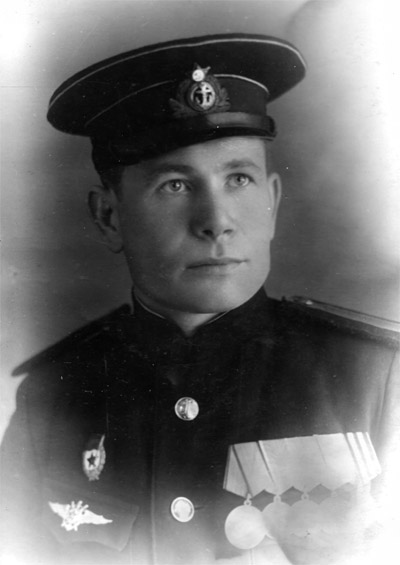
Alekseev Dmitrii Dmitrievich. 1948
Dmitriy Dmitrievich Alekseev: I was born on the 25th of December 1914 in Kuryanovo village, Kirillovskiy district, Vologodskaya oblast.
My father enlisted in the armed forces in 1914, and as there was no news from him, it was believed that he had perished. I was named after him. But he was a sailor, and served in the 1st Mine-Torpedo Company of Baltic Fleet; he was captured and held as a POW in Poland. He returned in 1919, when Soviet regime was already established. I was 5 years old at the time, and I can recall it even now.
We lived quite well; we had four cows and a garden. We had our own pigs and sheep. We would go pick berries and mushrooms in the forest. There were six children in our family, and my dad provided us with food, clothing, and footwear. My older brother Anatoliy was born in 1912; I was the second, and after 1919 four sisters were born. After his return, my dad worked as a lumberjack, and at the same time he built us a house. He would go to the forest on a horse for a week or 10 days, and then he would come back and have several days off. It was “socialism” time. I do not know anything about “capitalism” time – I do not remember that time, except what my grandma used to tell me. Then collectivization began.
When Kolkhozes were organized?
If I remember correctly, it began in 1930. I remember this episode (I was 14 years old at the time): Mom’s brother sent us a coach. It was so well polished, that there was no need of a mirror – you could see your reflection in its sides. It even had rubber tires, which provided a very comfortable ride. They used to produce them in large quantities in Danilov, like cars are produced nowadays.
My father and I came to Kirillov, and the local militia asked him:
— Father (Father: respectable way of addressing to males 40 and older), will you sell us this coach? With horse. We are ready to pay you good money for it. If you won’t sell it – it will be taken by the kolkhoz without payment.
Dad thought for a while, and sold it. And it was the right thing to do.
Where did you study?
I studied at Nikolskiy Torzhok village, which was located around 2.5 kilometers away from our village. There was a 4-grade school. After that I studied at professional-technical school at Nikolskoye village, which was ten kilometers away from us. I studied there for three years. I was taught rather well and got a profession—“mechanic, fourth level.” My brother also studied there, and he later left to be with my uncle, who lived in Moscow.
I finished professional-technical school in 1933, and with seven other graduates I was sent to Leningrad. It was February or March. Near Pushkin Theater was a management office, where we were given our orders. We were sent to Kingisepp. When we arrived at Kingisepp, we lived in “Peasants home.” It was a hostel, where for a small fee one could get a bed and food. We started to work at the workshop – we had a military order, and made “Finnish knives” for the army. For some reason, in about a week’s time we decided to go take a look at the Estonian border. We were caught by border guards:
— Where are you going?
— We want to take a look at the border.
He took us to the headquarters, where a report was drawn up and sent to our workplace. We were immediately fired and sent back to Leningrad. Five men left for home, but I, along with another guy, stayed in Leningrad. He used to have some relative, who worked in a “Big House” and wore four rhombuses. (The NKVD building at Liteyniy prospect is called the “Big House” because “from its cellars you can see Kolyma.” Rhombus – a rank identification sign in RKKA before shoulder straps were introduced in 1943.) He arranged free food for a month for us and allowed us to stay at his home. He used to live with a wife and a small child in a three-room apartment, and he let us to stay in one room. There was one huge square bed. We lived there for a month. I still can remember the address: Gorokhovaya street, building 6. For a month we looked for work, and as we had no money, we traveled through the city on a “sausage.”
What’s a “sausage”?
It was a rod, used for connecting tram wagons. After one month we were asked to leave, and we had to live on the streets and railway stations. But I did not want to go back home – life there was not easier. So, through May 1933 I lived on the streets. At the same time there was hunger in Ukraine, and a lot of Ukrainians fled to Russia.
Each day I used to go to the labor exchange office, which was located near Sytnoy market, but there was no job for me. The problem was that I had no registration in Leningrad. Finally, a place for me was found in Sovkhoz Priyutino, which was located four kilometers away from city toward Vsevolozsk. There was a place at the hostel, and I got a job as a mechanic. There were six tractors “Fordson-Putilovets,” the metal wheels of which were taken off and replaced by tires, and a “Polutorka” [1.5-ton truck]. Drivers courses were organized, and getting a drivers’ license at the time was even more difficult than becoming a cosmonaut these days. There was even an electro-station in our village. I had to do all kinds of work there – I had to operate the electric power plant. I almost died in the fuel tank, which I was cleaning from inside. I was even a cashier, and this specialty almost landed me in the prison.
I was a stupid kid at the time, and my first vacation was closing in. I thought: “When I go home, I will have to bring something with me; they are living rather poorly.” When kolkhozes were organized, all of the cows, pigs, and sheep that my family owned were taken away from them—only one cow remained. So I started collecting money. I was selling different things to the kolkhoz workers. Our Sovkhoz was a very rich one, and everything cost very little money. The Sovkhoz fed both the “Big House” and the Artillery school. When my time for enlistment would come, I wanted to go to this school. But I was caught on the “fraud.”
Money that I received from selling things I had to give away to the chief cashier, and he would give me the receipt. This time he gave me the receipt in advance, and when time came to pay salary to the workers, there was not enough cash in the main cash department. There was a rumor that someone stole the money, and it happened so, that just day before I was in the restaurant in Vsevolozsk with my comrade. And he told someone that he saw a lot of money when I paid for food. Thus I fell under suspicion. My apartment was searched, and they found a lot of money in my room. I should have kept the money in the bank, but I thought that it would be safer in my room. All the money was confiscated, and I was fired and sent to the “Big House.” I still remember that I went into some office on the third floor, where inspector Kozhevnikov interrogated me. I thought that I was going into the prison for sure, but he just laughed at me, called me an idiot, and set me free.
Did they return the money to you?
I was so happy that I avoided imprisonment that I didn’t care. But here I was again—no job, no money, and on the street. I had one friend, who worked in the cultural department. I asked for help:
— Can you help me? There is no way I will get a job by myself now.
He arranged a possibility of education for me. I studied to become a film-mechanic. The courses were located at Fontanka 3, while my hostel was at Ligovskiy 93. It was still 1934, perhaps the worst year of my life… I finished my education and started working on a truck-mounted cinema. I used to go to different villages and show films there. Already there were movies with sound, but I still worked on silent films. I worked through 1935 and the beginning of 1936 in this manner, until I accidentally burned a part of a movie. 112 meters of film was damaged, and I had to repay for the damage. 1 meter cost 1 ruble, and my salary was 65–80 rubles.
At this situation the army saved me. In May 1936 I was inducted into the army. To be exact – the navy. I was called to Baltic Fleet Crew, which was located at Gertsena street, 69 (Fleet Crew, it is more or less like barracks for Navy junior ranks, where sailors await further directions). We were given all that a young man would need, beginning with combs.
For further education I was sent to ShMAS (junior aviation technical personnel school) which was located at Vasilyevskiy island at Kozhevennaya street. We used to go to the “Sevkabel” factory’s canteen for dinner, and there was a great view of the Finnish Gulf from the second floor. I remember we were dining there, and suddenly a TB-1 bomber fell into the water. It was rather shallow place, and the plane’s tail was sticking above the water. I still can remember the number painted on the rudder: “blue 8.” The airplane was there for about a month, and it seemed that no one was interested in its fate; then, suddenly, it disappeared overnight.
After studying for four month, I was graduated as an aviation motorist (engine mechanic), and was appointed to the 20th Squadron, which was stationed in Oranienbaum. The squadron commander was Kuznetsov, a famous pilot and a very nice person. We had wheeled R-5 planes and both wheeled and float versions of the R-6.
Here are a couple of episodes of that time. I had to change the magneto on the plane, and we were rowed towards it, when a motor boat went past us and our boat overturned. I barely made it out of the water – I really can’t swim. The magneto sunk, and I thought that I would be made to pay for it, but no. Everybody was happy that I made it out, and there were no consequences to me.
Second episode. When there were Baltic Fleet maneuvers, we lost six R-6 bombers in one flight. There was a big investigation, and a rumor went around that there was a mechanic who would damage the controls so that they would endure takeoff, but would snap later. How it was found out? They raised a couple of these R-6s from the bottom of the sea. We were not told the results of the investigation, but it is a fact – there were acts of sabotage.
In 1937, at Bezzabotnoye, the location of “Rote Fahne” kolkhoz, a new regiment was organized – 1st Mine-Torpedo Aviation Regiment (1st MTAP), and I was sent there. The village was very small, and we had to live in Strelna, which was six kilometers away. Everyday we used to go there and back by foot.
There were a lot of famous pilots in 1st MTAP, and there were “international crews.” For example, one pilot was a Gypsy, navigator – Ukrainian, and the gunner could be Russian.
Were there any “tensions” based on nationality?
Tensions? No, we used to live like a family.

Technical crew of 1st MTAP, 1937
Where did you live?
In barracks, but officers lived with their families in their own houses, which were built especially for them. At approximately this time my father came to me. He was very sick, and I arranged for him to be treated at the Military Medical Academy, but he still died in 1938.
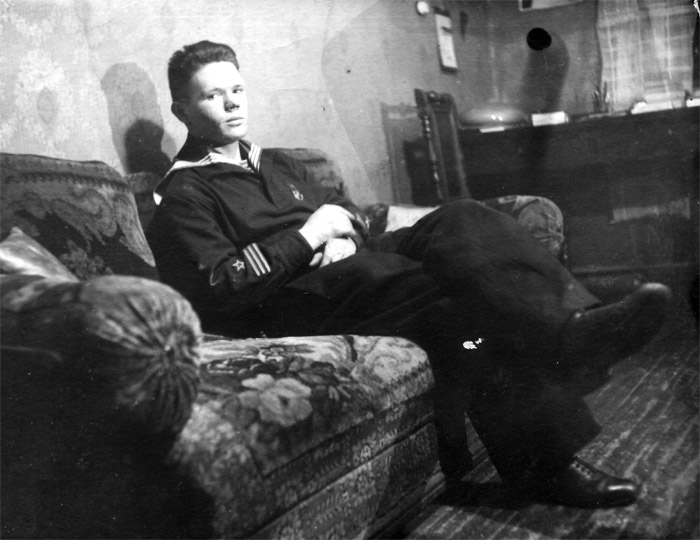
Nikolay Afanasyev
Which airplanes were in 1st MTAP when it was formed?
Same R-5, R-6 and small ones – U-2 and UT. The R-6 were on floats, which for winter would be changed to skis. It was a time when aviation was just getting on its feet. I saw with my own eyes how airfields Ropsha, Klopicy, Koporye, Kotly, and Alexandrovka were built. I live longer, then these airfields, last one of them was closed twenty years ago…
I was a mechanic in a command flight, and mostly I serviced the planes which were used to train parachutists and pilots. Conveyor flights – touch and go practice. I got used to my work quite quickly, and wasn’t thinking of it as of work any more, but as pleasure. But there were a lot of things to do, actually. For example, if something went wrong, we had to move the plane from the runway.
My U-2 was flown by Preobrazhenskiy and Babushkin—not the Babushkin who saved the Cheluskintsy. Our Babushkin became squadron commander. But once, when politicians in Estonia started something against Russians, he led about 20 or 30 airplanes over Tallinn on a low-level flight. They asked him:
— Why did you do this?
— I wanted to show them that we can punish them, that we have aviation.
— You scared ordinary people by your flight.
So, he was thrown out of the army. I remember, he used to walk around the airfield with a small white dog. Everybody thought that he was unjustly punished. He was a very good man. Later he returned to us.
But work was interesting. Something happened on a daily basis. An airplane would miss the runway and land somewhere else, lots of accidents. We used to bring SABs to Riga by our planes. When a plane would land and our man would start to unload it, all the local girls would run to the fence and start showing us all of their “beauties.” And they would start to turn this and that way, so that we won’t miss a thing, and shout to us:
— Hey, Russian, want some?
We were young boys, of course we wanted! All work would stop as long as we enjoyed the show, until our commander spotted us:
— You bastards! Return to work! We came here not for f…g with locals, but to unload these bombs!
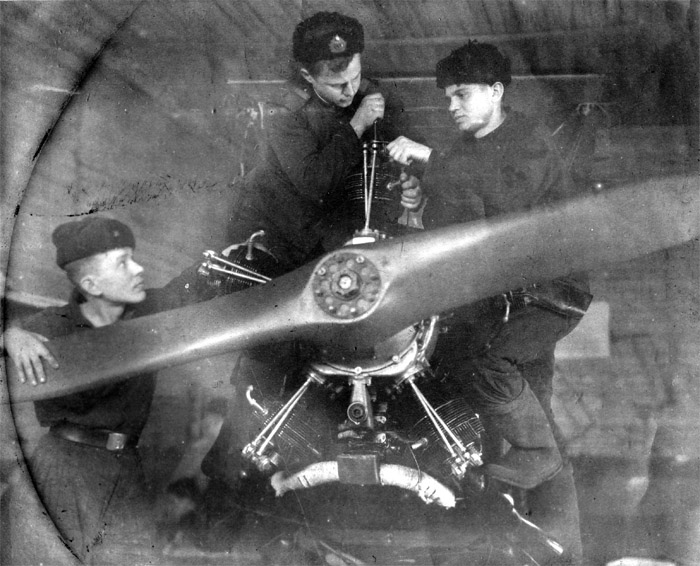
Servicing M-11 engine, 1943
Were there accidents?
Not too often, but it happened. Either because of incompetence, or because of recklessness.
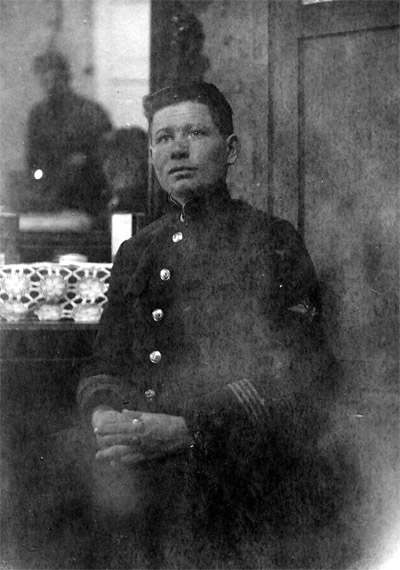
Alekseev, 1938
And what about “showing off”?
Showing off? Pilots always want to show off in front of each other, but our commanding officers didn’t allow it.
Were pilots punished if they crashed a plane?
They could be. But there always was an investigation. For example, there was one time with Kurzenkov during war. We had “Hawkers” (Hurricanes) then. These planes had common problem – if a pilot would press the brakes too hard, or would hit a bump while taxiing, it would tend to overturn. Most commonly a propeller was damaged in such cases, but if the tendency to lift tail wasn’t too great the rear wheel would be torn away. And here is a situation: pilot fought in the air, was shot at and shot at the enemy himself, returned to the base, and while taxiing he tore rear wheel away. The regiment commander ordered: write a report! And he wrote: I am guilty, I broke the airplane…
We told him:
— Write: broken because of metal fatigue.
Those Hawkers were really old even when they were received from Brittish, so when he wrote: “Broken because of metal stress,” the commanders preferred to believe him. And there was no punishment for him.
There were three brothers – Kurzenkovs. One flew in our first squadron, the second flew on Pe-2 at Black Sea, and the third one was studying in flight school to become a Shturmovik pilot.
Let’s return to the time when you received DB-3. What can you tell us about this aircraft?
I don’t remember exactly, but if I’m not mistaken we received them in 1938. The DB-3s were the newest airplanes at the time, and when we had lessons about this plane’s construction or servicing, we were told not to make any records. It was feared that some of the notes could get into the wrong hands. It had a crew of four: pilot, navigator, gunner-radioman, and gunner.
Didn’t the extra gunner appear only during GPW time?
No, our pilots demanded an extra gunner already in the Finnish campaign. Very soon pilots refused to fly without one:
— I will not fly without one; I’ll be a sitting duck up there!
At first anyone who could shoot from the machine gun flew, but later gunners underwent serious training – for example they could tear a cord which was used to tow target cone by bullets.
Sometimes only gunners were killed. In December of 1939 or January 1940 we were based at Bezzabotnoye. An airplane came back, but both gunners were killed. Their wives were wailing over dead bodies. They saw that a plane was coming in to land, and ran to meet them, but they were dead.
How well was DB-3 in pre-flight service?
It was pretty good and easy plane to service, but the main problem was that we had no special tools and instruments for it.
Where and how did you meet Finnish war?
If I’m not mistaken, we were based at Klopici at the time. Right before that war my time in the service came to an end, and as we were suggested to continue serving on professional terms, I agreed. Before the service, my civil life was less than easy, and I wasn’t too keen to get back on the street. I really liked the service – I was fed, dressed, had an interesting job, I had a separate room in the hostel.
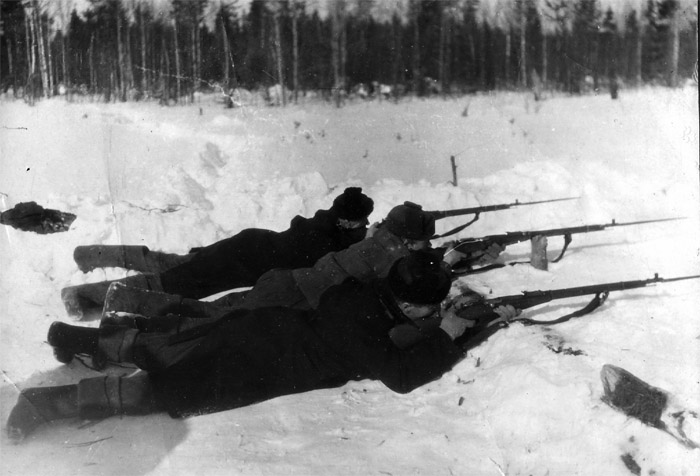
Technical crew is practicing at the firing range
What was your rank at the time?
Starshina. I had four gold bandages on my sleeve and a “chicken.” We had beautiful black Navy uniforms. We used to install fabric pieces in the lower part of the pants, it was called klesh. Patrols used to cut them out right on the street. We also had white jackets for parades.
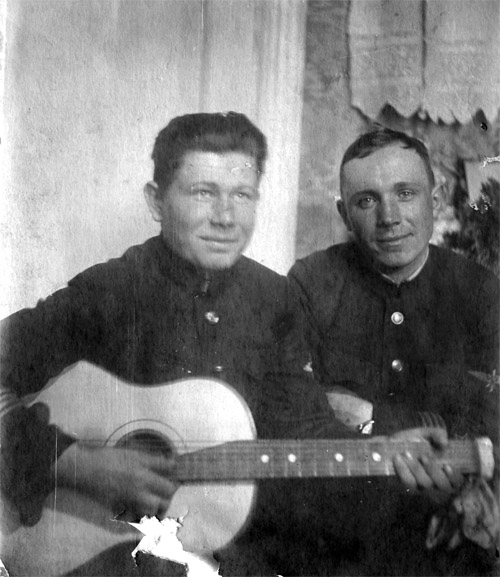
Alekseev (with the guitar) and tecnitian Zuev
Do you remember tactical number of the plane that you serviced?
No, I do not. There was “9” and “3,” but there was no “13” in the regiment.
What was the color of the tactical numbers?
Red.
How many squadrons were there in 1st MTAP?
Four.
Not five?
No. I remember: in 1938 we had four squadrons. The commanding flight was removed, and Babushkin was appointed as squadron commander. I had a lot of pilots who flew on my planes. Efremov flew, then Zelinskiy. Later one never tried to jump with a parachute; they tried to make him, but he always replied:
— It’s better to be called a coward once, then to become a cripple for the rest of my life!
I remember how he surprised me during a party meeting: It was discussed, if I could be accepted as party member, when he suddenly stood up and said:
— No, he is not ready yet. We should not accept him; he has a lot more to learn.
And I was not accepted! Only one was against – and that was it! I thought then: “I work for you, prepare your plane, and you turned out to be such a SOB!”
I was accepted as a party member in Safonov’s regiment.
What kind of losses did your regiment suffered during the Winter War?
Our 1st MTAP had 60 planes in four squadrons, 15 aircraft in each squadron. At the end of war we had only 40 planes left. There were no official conclusions, but there were rumors.
Were there any reinforcements?
We were not told…
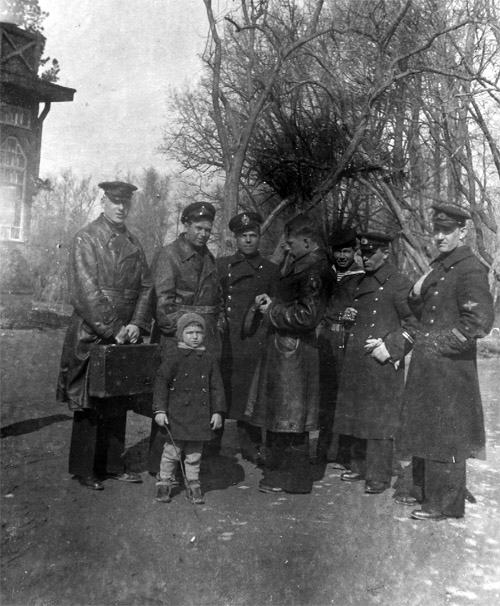
1 MTAP 1940, Bezzabotnoye
But you should be able to see, if a new airplane appeared on the field?
Our regiment was based on different airfields. During the Winter War we lost 20 planes. But these are all losses, not only combat ones. Before I forget – there was an accident on our airfield with one of our planes. It was attempting to take off with three FAB-500s on board. But the pilot lost orientation, and began takeoff heading toward the bomb storage.
Did he take off?
No, he didn’t even raise the tail. There was a huge explosion, or to be exact – a series of explosions. I didn’t hear such an explosion even during the GPW. Thirteen fighters were damaged—eight were blown to pieces and the rest were damaged by shrapnel. Human losses were somewhere in the range of 25–30 men. A starshina who was issuing bombs out was killed, and all that we found from him was a leg in the sock. Surprisingly, one of the weapons officers survived the explosion, even though he was in the epicenter – he was covered by the wooden bomb package. Several houses that were built in the forest not far from the airfield were damaged. Not only the window glass was broken, but even doors with door-casing were torn away. At the Volosovo station, which is about 15 kilometers away, school boys were injured by fragments of broken glass, and they were brought to us for first aid.
Wasn’t the bomb storage facility surrounded by an earthen wall?
By barbed wire only. We started to build walls around fuel and bomb storage facilities after this accident.
Could the DB-3 lift 1,500 kg in the first place?
It could, if less fuel would be taken, and take off on skis required extensive training, which our pilots lacked.
Do you remember who the pilot was?
I remember what he looked like, a rather short guy. But not his surname. His wife worked as a doctor at the ambulance, and when explosion happened she came to as, and kept asking:
— Did my husband take off?
Someone answered:
— He sure did.
What’s his name? No, I can’t recall. There was a lot of damage done to the regiment, but we never discussed this matter – we were afraid to talk about it.
During the Winter War there was a lot of strain on us. It was –50 degrees, but we had only moleskin coats to keep warm.
From Accident report at units of 8th Air Brigade
“3. Fatal accident. DB-3, 1st Air regiment, 30 November 1939, Klopitsy.
During take-off with bomb load of 3 Fab-500 senior pilot of the 2nd Squadron Lieutenant Chiryev deviated to the right. He failed to terminate take-off, headed 120 degrees to the right, and collided with bomb dump. The airplane exploded on its own bombs. The crew Lieutenant Chiryev, navigator Lieutenant Krepets, and gunner-radio operator Cherenkov perished. Three more people standing nearby were killed and five more received heavy injuries.
Two DB-3 airplanes, one R-5, and one U-2 were damaged from the blast.
Reasons: Pilot Chiryev did not terminate take-off after deviation from the runway line. Commander of the 1st Air Regiment who cleared a sortie with full load (bombs and 2500kg of fuel) with ill-prepared young pilot”
What type of coats?
Moleskin. They were made from cotton-wool, and that is not something like a fur coat. You couldn’t bend the sleeves; it didn’t keep you warm at all, you walk like in a snow-pile. We used to dry them around metal heaters, and when we were at Koporye, they once caught fire.
How did you keep engines warm?
Petr Kuznetsov had a motorcycle engine, so we would start it in the building, and then we would carry it to the parking space. As long as we carried it, it would work, but when we were about to leave, it would stall. It was the only way to warm up the engines at first. As I said earlier, there was no equipment for the DB-3 at the time.
Then we got “APL” lamps for warming engines, but there were not enough of them, and we still had a lot of problems.
We were completely unprepared for the Winter War, and later everyone just “forgot” about it. As if nothing happened at all.
But I still remember how cold it was, how the chief of staff used to come to us with a teapot full of spirit – you can drink as much as you can. That is the answer for your question: how well we were prepared for Winter War.
Do you remember which engines were used on the DB-3? M-85 or M-86?
Both, if I remember correctly.
Did you take notes, for how long you would warm up the engines?
There was a special journal, where we would note everything – which engine, when started, when shut down, when it is supposed to be changed. But sometimes it was all different – the engine was worn out a long time ago, but there was no spare engine to replace it; we worked miracles to keep them running. Our PARM was at Bezzabotnoye; we changed engines there.
What was the engine’s anticipated life?
600 hours.
It is written, that our engines had a planned life of no more than 200 hours.
In the beginning, engines came with a useful life of 50 hours; later they managed to raise this number to 600. Some engines worked for more then a thousand hours. But the Winter War was short, and we didn’t change a single engine for wear-out reasons. August of 1941 was a time when we had to change a lot of engines simultaneously. I reported:
— The engines are completely worn out. I cannot allow this plane to fly.
We were stationed at Kotly, and for an engine to be changed we had to fly this plane to Bezzabotnoye. There was an order – no take offs without a bomb load. We had 10 FAB-100 in the fuselage. I made a “nest” above the bombs, tied myself to the airplane with a rope, and we took off. Smirnov was the pilot. We took off, crossed the battle front, he opened bomb bays. We were no higher than 300 meters above the roads. Trees were cut on both sides of the roads, and I could see everything “like they were on a plate.” Germans were running away from the road, trying to hide. There were a lot of tanks, armored cars, trucks, carriages, horses, and soldiers. The road was completely clogged with troops; there was no need to aim – you would still hit something. AAA started firing, and our plane started “jumping.” I felt that this bomb run will never end, but finally the bombs left our plane, and you could feel that it became easier to fly.
Did you see where bombs fell?
Of course! It was like in the movie. Explosions covered the road. Then, suddenly, three Me-109s appeared out of nowhere. They hit our engine; the second one was old and not working well. We were going down in a shallow dive. We barely made it to Pulkovo and landed near Voronino. When the landing gear of DB-3 was raised, a small portion—about 15 centimeters—of wheels are still outside. Smirnov managed to put the fire out by diving, and landed so smoothly, that the underside of the plane was not damaged – we only bent the propellers. There was a big cloud of dust, and the gunner decided that the plane was on fire and was about to blow up. He jumped out of his cabin and ran away. He forgot about me, pilot and navigator.
How did you make it out?
Somehow. We looked at the damaged engine, and there was no fire. It was covered with oil from a damaged cylinder. We radioed to our home base and let them know what happened. A truck with engines and technicians came the next morning. For two weeks we were repairing airplane, and all I had for food was milk.
Who flew out when you repaired the plane?
Smirnov returned and took off alone. He flew to Bezzabotnoye, and we went home by truck.
Let’s return to the Winter War. How were your planes painted?
They were kept silver. We had no time to repaint them. We tried to cover them with tree branches. During the GPW we were trying to raise a DB-3 after belly-landing at Kotly airfield. We dug trenches under the landing gear, to release them, and roll the plane out. In order to hide our activity we covered the plane with branches. Soon a German plane flew above us, so that we decided to hide in anticipation of a bombing. We spent the night at Kotly village, behind the cemetery. In the morning I was returning to the airfield, when I heard:
— Stop!
Seven men approached me, and they took away my pistol, two grenades and my gas mask:
— Who is your commander?
But I couldn’t answer – it was forbidden by the law. I said:
— Let’s go, it’s not far from here, I will introduce you.
— We are not going anywhere.
— There is no reason to talk to him, he’s a spy, let’s shoot him!
“Hey, that’s me they are going to shoot!” My hair stood up! I thought: “And what will be the reason for my death? If these bastards will really kill me, what did I live for? And the war has just begun.”
One of them turned to be reasonable enough. He took two soldiers and walked with me, and the problem was solved.
You had a personal airplane to service, or you worked on all airplanes?
There was a special order issued, that stated, that no one should be allowed to enter the plane after the mechanic left it.
When was this order issued?
Right before the Winter War. Once the mechanic had sealed a plane, it was passed to the guard, and after that he wouldn’t allow anyone to enter the plane. Why did this happen? Because you would prepare the plane for a mission, and on the next day you would come to the plane, and during night time someone would cannibalize the plane for spares.
What kind of weapons was used during the Winter War?
To be honest – I do not know. There were special weapons personnel.
But they hung bombs under your plane?
There was no time to look at it – I had my own work. When aircraft would return from a mission, we would start simultaneously servicing it. Each one of us would do our own job.
Weren’t you responsible for their work?
No, they had their own commanding officer, who was responsible for their work.
Did you see air-dropped mines?
I never saw them.
Do you remember how the Winter War ended?
Not really. It started quietly, and it ended also quietly. We were assembled at late spring and had a week’s rest at Razliv.
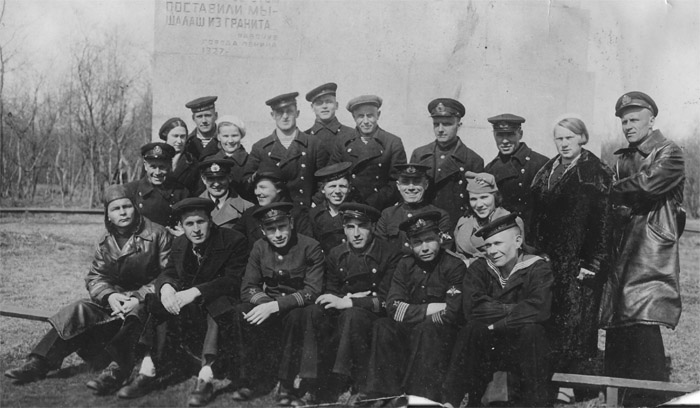
1MTAP, Razliv. 1939
1st row 2nd from right – Alekseev
And what about the parade in Leningrad?
After the Winter War? Never heard of it! There was a parade after the GPW ended.
What happened during the period between the wars? Was there a feeling that a new war was coming?
There was no shadow of a doubt that war would be coming soon. There were a lot of spies. Flight crews came from restaurant, and told us:
— We are simply tired, we are constantly asked: Where are we located, who is our commander, what types of planes we fly, what kinds of flight characteristics they have.
Eventually they stopped going to the city in uniforms.
Did you receive new airplanes after the Winter War? “Cigars”, maybe?
Yes, we received new planes. The actual difference between “Cigars” (DB-3f) and “short nose” (DB-3a and b) planes was in their looks.
Maybe pilots told you which planes they preferred? For example, Razgonin used to tell us that he preferred short versions, since long versions were “heavy”.
I only saw “Cigars,” I didn’t work on them. But I liked my “Bukashka”.
How did you learn that the Great Patriotic War had begun?
At that time we were in the summer camps, at Kotly, about 120 kilometers away from Leningrad. We heard Molotov’s speech over the radio. The first bombing raid was on the 5th of July.
You bombed, or you were bombed?
We were bombed. Before that our planes flew reconnaissance. When aircraft returned, we all would run to the plane, to hear the latest news. Once, right at the moment when we stood around an aircraft, a German reconnaissance plane flew over us. It was clear that our airfield had been discovered! We expected the air raid, and we moved all the planes to the sides.
Kotly, in my opinion, was the best airfield of all I saw. It was clear, and planes could take off or land in different directions. Bombing raids happened from July 4th to 5th. The first victim was a waitress from our canteen; she was going to the canteen and was killed.
During the bombing raid only a waitress was killed?
There were some casualties, but only the waitress died. We woke up early in the morning. Planes were moved as far from each other as possible. Suddenly bombs started falling. Everything was covered by either smoke or dust. We couldn’t see what was going on. Two mechanics and technician Galitskiy were working on my plane, when a bomb exploded near it. Two fragments hit Galitskiy in the back. I crawled inside of the plane, took bandages from the first aid kit, and started bandaging him.
Were there first aid kits in the plane?
How could there be an airplane without first aid kit and NZ [untouchable supply]? There was even a special man, who would go around the airfield and hand chocolate bars to crews that were about to take off. The raid ended and the ambulance came and took the wounded away. Motorist Moroshkin was thrown up to two meters by explosion, and had broken his nose when fell on the ground. He bled like a fountain. But I didn’t see any dead; no one discussed that someone besides the waitress died. After the war we met once again, and Galitskiy recalled that bombing raid. He used to live in Taganrog, and he should live there now.
How many planes were damaged?
My plane was slightly damaged by fragments, but I can’t say anything about other planes – I was busy with mine. I didn’t see any burning planes, though.
How did you repair the bullet holes?
With metal – there was a PARM for that. In percale – we would glue a piece of percale and paint over it with emalit (type of a dope).
Were the fuel tanks on your planes protected?
They were metal, at first plain metal, and later – with rubber coating.
How did the anti-icing systems work?
We learned that from the Americans. Alcohol would be applied by syringe to the propeller blades and windshield. Portion – one hundred grams. The tank had fifty liters’ capacity. On the wings there was a “Goodrich” system – there were rubber tubes, and warm air would be applied through them, and ice would fall. Alcohol was also used in hydraulics – a mixture of glycerin and alcohol.
Was this mixture flammable?
It didn’t burn; we tried to experiment. More experienced technicians used to go round the flask with alcohol, trying to get some. For a long time I couldn’t understand what they needed it for – I didn’t drink alcohol at the time.
How did you end up in the SF [Northern Fleet]?
We became “horseless,” and I was taken out of 1st MTAP. But before that all planes were cross-checked, and 15 planes were selected. They were used on retaliation strikes on Berlin “for Moscow and Leningrad” during the night of 7\8 August 1941. They were led by Preobrazhenskiy
By the way, what was strange about Preobrazhenskiy – he could be dressed in Naval, or Army uniform.
Where did they fly from? Saaremaa?
I can’t really say. It was done in such secrecy. A special mission by government order. Where they flew – we did not know until the article appeared in a newspaper.
You said “15 planes were assembled.” How is that? Planes were cannibalized to bring these planes into best possible flying condition?
We barely managed to get 15 planes. Otherwise our regiment was almost completely destroyed, and this mission required putting greatest strain on technical crew.
These planes were loaded with ZABs, and they flew to Berlin. As our crew members recalled, it was clear weather, Berlin was all in electric lights. They picked military objects and bombed them.
And what is your opinion?
They returned without problems. That they bombed Berlin we heard over the radio and read in the newspaper. But it wasn’t told, that it was our crews, so we just decided that it should be our crews. We cheered that we didn’t work for nothing. Later, throughout the war, I heard rumors that all crew members that bombed Berlin were declared as Hitler’s personal enemies, and that under no circumstance they should be taken into captivity by German forces.
Where did you prepare the planes?
On the continental part.
It is written that they flew from Esel.
They hung bombs on the planes, flew to Esel, refueled the planes there, and took off again. They had to fly for several thousand kilometers above water in a plane that had worn out engines and an overload. It was a big risk, but they made it. Goebbels announced:
— We were bombed by British! There were 150 planes; 15 made it to Berlin, and dropped their bombs. Five planes were shot down over Berlin. Russian aviation is completely destroyed, they have no fuel, they have no crews.
But we had announced that it was our planes. There actually were 12 that made it to Berlin, and they all returned to base. The British announced that none of their planes took off due to heavy overcast.
When these missions were complete, what happened to the planes?
I can’t remember. By this time I was “horseless.” Soon I was sent to Saransk, where pilots and technical crews were assembled and later sent to different Fleet air forces. When they sent me to Saransk, I said:
— My mother and four sisters are dying in Leningrad. I want to return to the Baltic Sea.
— We know where to send you.
This city was very dirty, when a rain would fall, ground would turn into a marshland. Meanwhile, on almost a weekly basis we went to the theater! For the rest of my life I visited theater less times, then in Saransk. Sometimes we were used as workhorses – we used to unload cargo from trains. There we lived in a club that had been converted into barracks, but we were fed in the restaurant! Eventually, we got tired from living in barracks, and seven of us moved to a rented apartment. Krasnaya street, 1. An order came – I was supposed to be sent to Moscow, to the front. But at this time we were playing football, and they didn’t find me. Right when the train was leaving, I came running to the train station. So I was asked:
— Where were you? Why did you miss the train?
They decided that I had done it on purpose, that I wanted to desert. I said:
— I would be happy to go.
I told them that we moved to another apartment, and that I wasn’t informed in time.
— Well, you will have to wait for several weeks, and you will have a chance to taste English chocolate.
Within two weeks, 22 men were selected; among them were I and Petr Sgibnev, who became regiment commander after Safonov was killed. We were given warm clothes, some food, and weapons, and we were loaded on a train.
How long did it take you to get there?
It took us one month. Once the train left the track, and we had to wait. And that’s when all military personnel were moved with highest possible speed. We arrived by New Years Eve 1942 to SF, to the 78th regiment.
This is how I ended up at SF. I arrived when the 78th regiment was disbanded, and on its base two new regiments were formed: 9th and 2nd Guards. The 9th remained on the old airfield. There were two airfields not far from each other – Vaenga-1 and Vaenga-2. I was sent to Safonv’s 2nd Guards. It was based at the small sea airfield, opposite from Gryaznaya Guba. When I arrived, the regiment had only two Hurricanes almost airworthy. Two Hurricanes.
When you arrived Hurricanes were already in the regiment?
Hurricanes were already on the airfield.
You spoke to pilots. How did pilots refer to the Hurricanes?
Hurricanes? They had good engine, Merlin XX. Good engine, reliable engine. You could start it with compressed air.
A lot of pilots complain that its engine was not too good – it was delicate and capricious.
Incorrect. The airframe was rather poor – it was prone to fires and rather poorly constructed. But engines if serviced well were great.
There were no planes left to fly in the regiment. What did we do? We gathered a team of technicians, and we went to collect fallen planes in the hills. Germans would shoot them down, we would collect them and send them in for repairs. MiGs were good fighters, but there were very few of them, and thus we collected only Hurricanes. Pilots knew where they lay, and we would take a tractor and a sled. We picked up those planes that could be repaired. Wings would be disconnected from the fuselage, we would put plane on the sled and the tractor would take it to the ARM (Aviation repair facility).
You put the plane on a sled and carried it or you dragged them?
The tractor would drag plane to the road, and we would put the fuselage on its wheels there.
How many planes did you collect?
I don’t know, we never counted. Maybe ten? I remember that all of the time we were pushed to the side – our tractor interfered with other troop movements.
How easy was the Hurricane to repair?
It varied. We repaired without any problems. It was basically of the same construction as Po-2 – it was made of canvas. We would apply patches with emalit.
There were some kind of sight-seeing tours from Molotov technical school. In the spring of 1942, closer to May, my plane was on Alert-1: with warmed up engine, I had no permission to leave the plane, waiting for a green flare. If one was fired, the pilot would run to the plane, and I had to help him to put on his parachute. One of the students came to me:
— Could you show me the plane?
— Here, get in and help yourself.
He got in the cockpit, and took the flare-pistol. I told him:
— Be careful, don’t fire it!
It was armed with a flare with two colors – red and green. And of course he pressed the trigger. The flare fired and start jumping across the cockpit. Eventually it stuck under pedal, where the hydraulic line was placed. The copper tube broke from high temperature. Somehow we managed to put out the fire. I said:
— See what you have you done. What if take-off will be ordered?
What should I do? Not far from this place there was a plane graveyard. I said:
— Keep silent. If anyone comes, tell them that I’m about to return.
I found a matching tube in the wrecks, disconnected the old one, connected the new one:
— Keep silent, or you will have problems. You are young, and you don’t need problems.
Luckily, there were no alerts, and I had time to repair the plane.
Could you tell us, that plane graveyard you mentioned, was it a place where signed-off planes were dragged? How many planes were written off due to plane damage?
I do not remember a single case when a plane was signed off. They were either shot down, or we would repair them.
But you took detail from signed-off plane?
Yes.
What was the reason for signing it off?
I don’t know the story of this plane – it was there already when I came to the regiment. It just lay there.
Were there many planes?
Not really, but I didn’t count.
Do you remember the Hurricane’s armament?
It had six machine guns on each wing. It wasn’t sufficient armament at all, so our technicians tried to change them for two ShVAK cannons. At first it was done in the ARM, and then in the regiment.
Where did they take the cannons from?
No idea. They had their own base, where there was armament.
Were gun ports in the wing covered with paper before take off?
Yes, they did… They would make a “condom” on a barrel, and then they would glue thin paper on the wing leading edge.
The Merlin XX was water-cooled, while the M-85 and M-86 were air-cooled. Wasn’t it a problem becoming accustomed to it?
We had to. When I arrived in the regiment, I knew two words in English: “ON” and “OFF”. I was issued a plane to service, and I had to service it. With time I got used to it.
How long were the Hurricanes used?
Until they all were shot down.
When Guards regiments were formed, did you became Guards straight away?
Same year, but later.
Were you paid for Guards?
300 rubles, if I remember correctly.
You gave us a P-40 handbook. When did they appear?
Kittyhawks were brought to us in big crates. They were assembled at Yagodnik airfield. The crates were made in such manner, that they didn’t sink in the sea. Later we used them for houses. When I was at Novaya Zemlya, we used to live in such crates, but there was a fire and they burned down. For several weeks we had to sleep in the snow. We would put a flag near us, so that our friend would dig us out in the morning. I got several frostbites then. What else could we do? There was no wood there; the winds were so strong that they blew all tents away on the first night. It was 1944.
So, when did the [Kitty]Hawks come to the regiment?
Our pilots began combat missions in May 1942.
When did you become a Kittyhawk mechanic?
When I came to SF, I was given two Hurricanes. We began studying the Kittyhawk in January 1942.
Kitty- or Tomahawks?
Both. They were identical, and we called them Kittyhawks.
In May 1942 they were flying?
Yes. I will tell you how Safonov died. On the 30th of May 1942, four planes took off: Kukharenko, Pokrovskiy, Orlov, and Safonov. He had a star on his rudder as a symbol, and no number. Pokrovskiy flew on “number two,” “number one” was Kukharenko’s plane, and “number three” was Orlov’s.
Colors? I’d say planes were green and brown in color. The numbers were red, same as the stars.
Whose plane did you service?
Captain Orlov’s. He was Pokrovskiy’s best friend.
Which squadron were they from?
There was only one squadron left. In the morning, somewhere around 8 o’clock, we prepared their planes, and they took off. They were supposed to find a shipping convoy, about 15 ships, and protect them from enemy air attack. Soon Kukharenko announced that he felt bad, and his engine was not working properly. Safonov ordered him to return to base, and Kukharenko left. There were three planes left now. Later we checked Kukharenko’s plane – it was fine, we found no problems.
So they met the convoy and everything was well. Soon a few planes appeared, possibly Junkers 88s. There were about five planes incoming. They attacked these planes, and Safonov shot down the leading plane. Orlov and Pokrovskiy also shot down one plane each. Two remained.
Boris Feoktistovich shot down one more, and started chasing a third. We heard over the radio that he said something about his engine, but we couldn’t understand clearly. He fell somewhere about fifteen nautical miles away from the convoy. Some sailors saw how he fell.
Did Orlov and Pokrovskiy see what happened to Safonov?
When they landed, I asked Orlov:
— Where is the commander?
Orlov:
— Didn’t he return?
It was clear that he was frightened. The commander is lost! Pokrovskiy came to us, and said:
— Pasha, let’s go. — and repeated, — Let’s go!
They went to the command center. In about ten minutes the entire regiment was lined up:
— The commander did not return. Sailors reported that they saw one fighter fall into the sea. Let’s hope that he was picked by an Allied submarine.

Pokrovskii by his plane (Hurricane?)
Did confirmation about Safonov’s two kills and Orlov and Pokrovskiy’s one each come from the convoy?
I have no idea. It was not my area of expertize.
Do you remember what engine was in the Kittyhawk?
On the Kittyhawk? Not sure. Allisons?
Do you remember when the Hawk’s engine needed replacement?
No, I don’t… Usually they either came in with a damaged engine, or were shot down. Engines didn’t live that long.
How did our pilots like the Kittyhawk? As I understand it, they didn’t like Hurricanes.
They didn’t like Hurricanes. The Hurricane was very slow plane. But its Merlin XX engine was rather powerful; it had a two-stage supercharger. There was a WEP [war emergency power], but it could be used for no more than five minutes. When I flew on Catalinas, the WEP could be used for up to 15 minutes.
What about the Allison’s quality?
Allisons were good engines.
It is a widely held opinion that they commonly blew when installed on Cobras.
No, I don’t remember such cases. But I serviced Allisons on the Cobra for a rather short time. My commander (pilot) then was Bokiy. Once he came from a mission, and I saw that it was him by the number. He couldn’t lower his landing gear. After three circuits he managed to lower it by hand. He came out of the plane completely wet—it was a very tough job—and announced to me: “Six days in confinement.” We started to look for a problem – and we found it. He accidentally switched the accumulator [battery] from recharging, and it went to discharge. There was a fight, he shot, and the accumulator failed. We couldn’t figure out whose guilt it was. Our armament officers checked synchronizers. It was a procedure to be done after each flight – there were cases when our pilots shot propeller blades off, and to avoid accidental engine start, they turned this switch off. It was impossible to start the engine in such cases. Cobras had two synchronous 12.7mm guns and either 37, or 39mm cannon. I can’t remember now [37mm].

Airfield Rogachevo, 1945.
The wing machine guns were removed?
No. They were not installed when we assembled planes. So I went to our garrison confinement facility and spent a night there. In the morning someone came after me:
— Come on, you have a plane to prepare.
Bokiy shot down one German ace, who had 96 kills on his account, including some from the Spanish Civil War.
There was a rumor that Hitler had only nine such aces at the time, and that they were in a special position. No one could order them where and when to fly. If he wanted – he flew, if he didn’t – even Hitler himself couldn’t order him to go to battle. It was rumored that Germans had only nine such aces. One of them was shot down by a MiG pilot, and they landed on some lake… I don’t remember which one exactly. It happened during winter time.
Was it near Vaenga?
— No, somewhere in the area we called “Norway”. (Petsamo area)
This ace flew with a dog. Our pilot also had to belly-land due to the battle damage at this same lake, and suddenly he noticed that a dog was running toward him. He got back to the cockpit and closed the canopy. When the dog approached, he slightly opened the cockpit and killed it with his hand gun. Germans had skis and some food in their planes in case of emergency landing, and this ace fled on skis. He left a parachute behind with a name on it – Muller. An order was issued to find and capture him. Border guards caught him 32 kilometers away from the plane, when he settled for a rest and fell asleep. He was brought to our airfield Vaenga-1.
He asked:
— Show me the pilot who brought me down.
At this moment, some pilot came in, and they shook hands. Straight away this Muller announced:
— I was shot down twice, but I managed to get away. If you will keep me alive, I will teach you our tactics.
He was sent to Kuybyshev, I think.
Our pilot, who shot down Muller according to your tale, was flying MiG. And what about Bokiy?
The first time I read this story in 1942, the pilot’s name was something like Zakharov, and he flew a MiG. In 1943 this story turned to Bokiy and this time he was flying a Cobra.
You were at Novaya Zemlya?
Before that I was at Yagodnik airfield.
How did you end up on Novaya Zemlya, and when did that happen?
It was in August 1944.
But let me tell you what happened during the autumn of 1943. The technical staff got some rest, and we were sent to Yagodnik. Something happened to my stomach there, and I spent a month in a hospital. Meanwhile, our regiment was sent to America after new planes. (Most likely pilots only “showed off” in front of their subordinates about visiting America – combat unit pilots were likely to receive their aircraft at Ivanovo in the ZAP) The senior officer was Saenko, but our technical crew was left at Yagodnik. There were huge workshops, where planes were repaired, some pilots were training. After the hospital, I had to service two Kittyhawks for training flights all by myself.
Our pilots told us that on the way to America, they were invited by Stalin to the Kremlin, and he wished them luck. But on the way back they had a problem with weather, and one plane fell into the taiga. They dropped a saw and an axe to the pilot. I still have no idea if he made it.
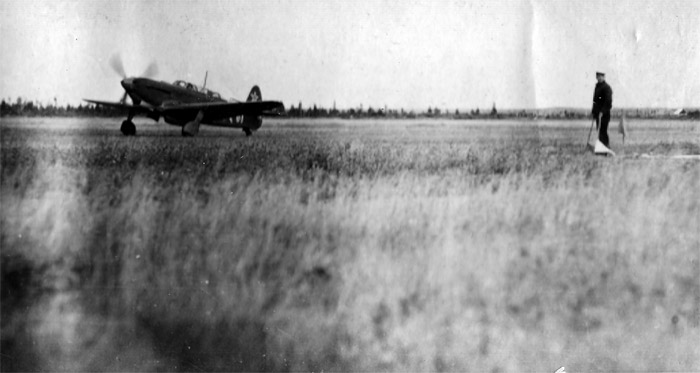
Training flights, 1944
Have you seen how English four-engine bombers (Lancasters) landed on Yagodnik?
No, I think I was at Novaya Zemlya then. But I heard about it.
Don’t you remember?
24 English planes, I remember – it was in 1943. Hamptons. Those English pilots landed with total disrespect of ground control commands, and several almost crashed because of crossing paths. I should have a photo somewhere. I used to be a regiment photographer – I bought a camera before war and made a lot of photos for pleasure or when someone needed a photo for documents. When journalists came to us, they sometimes even took my photos for their articles. I can give them to you, but I can’t tell you who’s on them – I’m almost completely blind now.
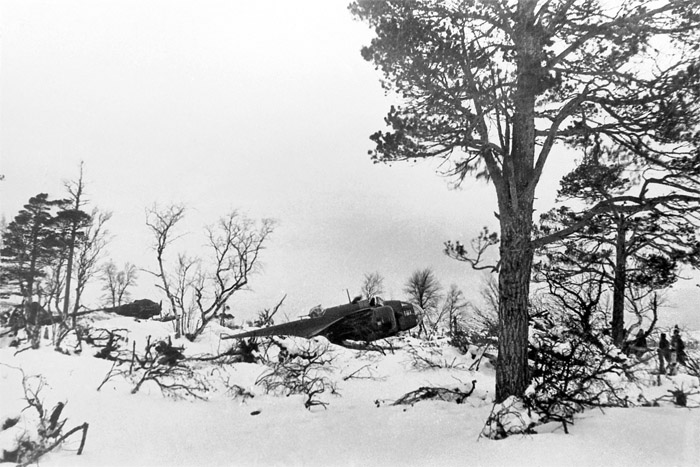
Hampton of VVS SF.
At the background captured Ju-88.
When it was repaired and an attempt was made to test-fly it, it crashed and all of the crew was lost.
So, how did you end up at Novaya Zemlya?
The Germans wanted to capture Murmansk and Arkhangelsk, and for that they needed Novaya Zemlya. We were brought there with a fighter squadron. There also was a bomber squadron; our planes were based at Rogachevo airfield. I serviced fighters. There were such fierce winds that we had to tie the airplanes to special poles which were hammered into the ground. There used to be Beluzhye port. Waves there were as high as 20 meters. We used to have four Catalinas there. To prevent them from being thrown to the shore, they were tied to special anchors. They were thrown to the shore with those anchors, and the planes were smashed into each other. Out of four planes we managed to assemble two. Here is a photo.
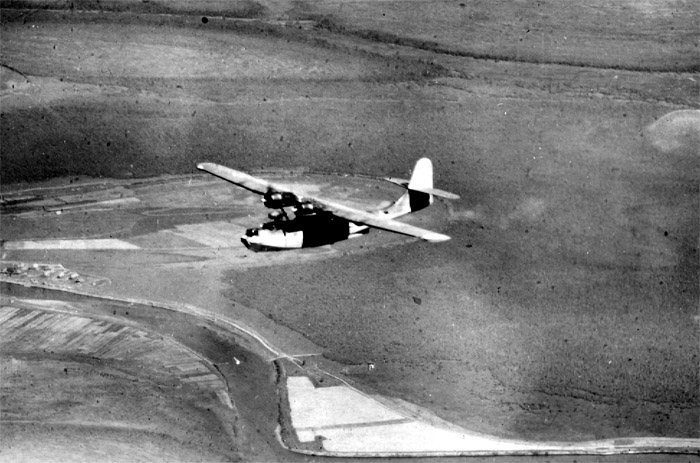
PBN 6 Y in flight
PBN 6 Y
Yes, exactly. It had a very good Goodrich de-icing system.
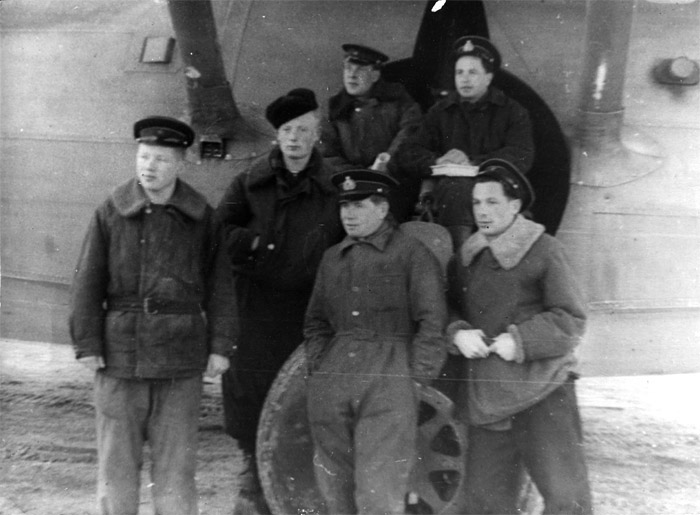
Near PBN’s wheel – Alekseev, to the right from him – Shlenskii
Were these Catalinas equipped with radars?
Radars? We had them, but we did not know how to use them. The crew consisted of seven men: two pilots, navigator, radioman, radar operator, two gunners in blisters with two M2 [.50 caliber] machine guns. And a flight engineer – that was me.
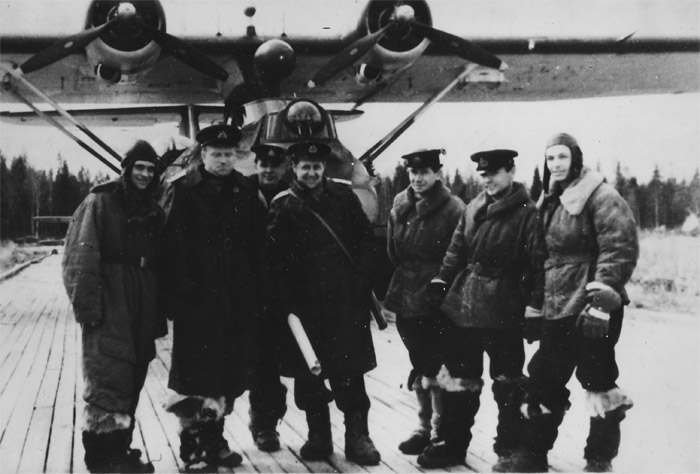
Airfield Vaskovo, Shlenskii, Bryzgalov, Alekseev, Agafonov, Baryshnikov, -, –
How long were you at Novaya Zemlya?
I met the war’s end there. We heard that the war ended over the radio, and to be honest – we were disappointed. We had spent almost a year with no action. There was no celebration there. In June–July we were sent to the continent. I placed all my belongings in the plane’s fuselage and never saw them again. The airplane was sent not to Yagodnik, but to Murmansk, where it was handed over to the Americans.
We were sent to continent by ship, and we saw three mines on the way back. They destroyed the naval mines by hand: They embarked in a small boat, rowed to the mine, attached a fuse to it, rowed away about 100 meters, and then detonated it.
How you were fed?
There was a canteen, and we were fed well. If one wanted he could go hunting – there were millions of geese there.
How you spent your free time?
We went to Beluzhye, there was a club. But we had to walk for 18 kilometers from Rogachevo. No actors came , there were a lot of talented fellows there. Nikolay Troilin, pilot from our squadron, was a good accordion player…
Were there films or newspapers?
No films, and very rarely newspapers.
You eventually flew on Catalinas?
Untill the end of war I serviced fighters. After the war I flew Nomad as a flight engineer. I once again signed a contract, and served until 1956. By this time I had 20 calender years…
Which plane was the best for you to service and repair?
We didn’t repair them, we serviced them. «DB-3» were good planes… But we didn’t have other planes to compare to. We were not ready to war.
I also liked «PBN-6». I flew as a flight engineer. It could land on water and at the sea.
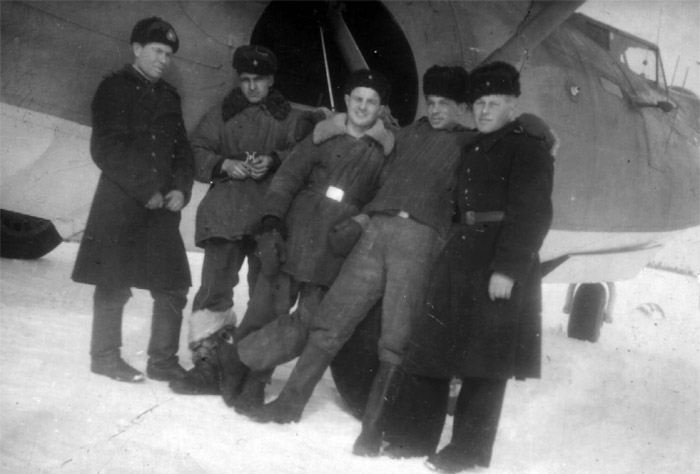
Archangelsk, airfield Lakhta. Alexeeev (first from right) with his comrades by the side of PBN.
And what about Cobras, Kittyhawks and Hurricane?
Cobra was a good plane with a reliable engine. Hurricane had excellent engine, but it demanded careful monitoring… It was started by compressed air… But the plane as a whole was a piece of junk.
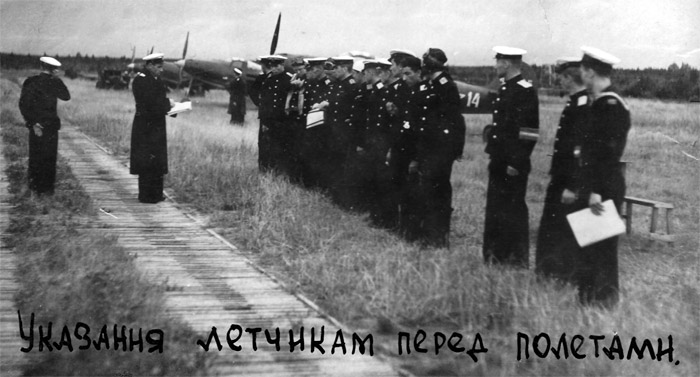
Rogachevo, 1945
And Cobra?
Also by compressed air, but it could be also started by electric starter. Hurricane was not that easy – you always had to have a full compressed air bottle. We even had to build a compressing station.
I remember like now: I was carrying a compressed air bottle, and Safonov was passing by in a polutorka (1.5 ton truck)… Suddenly it stopped, he ordered me to get in the cabin, while he stayed in the truck bad. He was a great man!
Yes… It was a long and interesting life. I can say – I didn’t live for nothing.
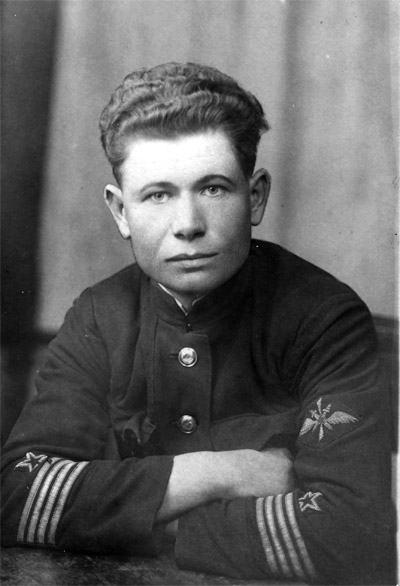
1 MTAP, 1939, Alekseev.
By Oleg Korytov and Konstantin Chirkin ©
Transcribed by Igor Zhidov ©
Special thanks to Svetlana Spiridonova and Ilya Grinberg
